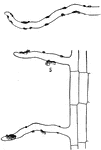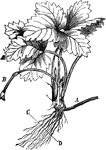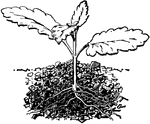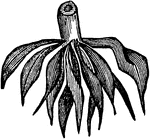
Fasciculated Root
"When the fibers of roots become enlarged by the deposition of starch, they form this variety of root."—Darby,…
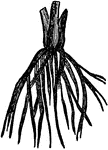
Fibrous Root
"This variety consists of numerous fibers proceeding from the neck of the plant, and may be seen in…

Napiform Root
"The variety which is very large at the base, but tapers abruptly, as in the Turnip."—Darby, 1855
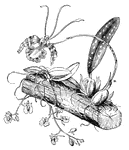
Orchid Root
Roots which never reach the ground are produced by certain plants whose seeds, lodged upon the boughs…
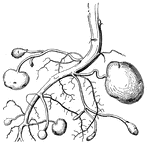
Potato Root
This shows real roots of the potato, as well as several branches of the stem, with potatoes forming…

Radish Root
So the biennial root becomes large and heavy, being a storehouse of nourishing matter, (Gray, 1858).

Rhizoma Root
"The Rhizoma or Rootstock grows in a nearly horizontal direction, emitting roots from its under side,…

Solomon's Seal Root
In some perennial herbs, prostrate stems or branches underground are thickened with this store of nourishment…
Tap Root
"When the root sinks perpendicularly into the earth, and tapers regularly from the base to the apex…
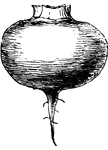
Turnip Root
Roots of the turnip are designed to absorb moisture and matter from soil, and to hold nutrients for…

Root-Grafting
"Fahlias and paeonies may be grafted by inserting young shoots into the neck of one of the fleshy roots…

Root-Grafting
"In the case of large woody plants thus worked the grafted roots, after the operation is completed,…
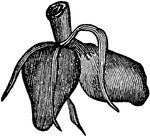
Didymous Roots
"Didymous roots are those which produce a tubercle each year, and when the tubercle of one year arrives…

Shield-Budding
"The simplest and most generally practised form of budding is that called Shield budding or T-budding.…
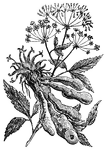
Skirret
Sium sisarum. "A species of water parsnip, generally said to be of Chinese origin, long cultivated in…

Seneca Snakeroot - Roots and Base of the Stem
"Polygala senega of eastern North America. It sends up several stems from hard knotty root-stocks, bearing…
Suckering Iron
"Root suckers are young shoots from the roots of plants, chiefly woody plants, as may often be seenin…

Vincetoxicum
"Vincetoxicum officinale. a, root; b, fruit; c, a single seed." — Chambers' Encyclopedia, 1875

Root-Grafting of Woody Plant
Grafting is a method of asexual plant propagation widely used in agriculture and horticulture where…


